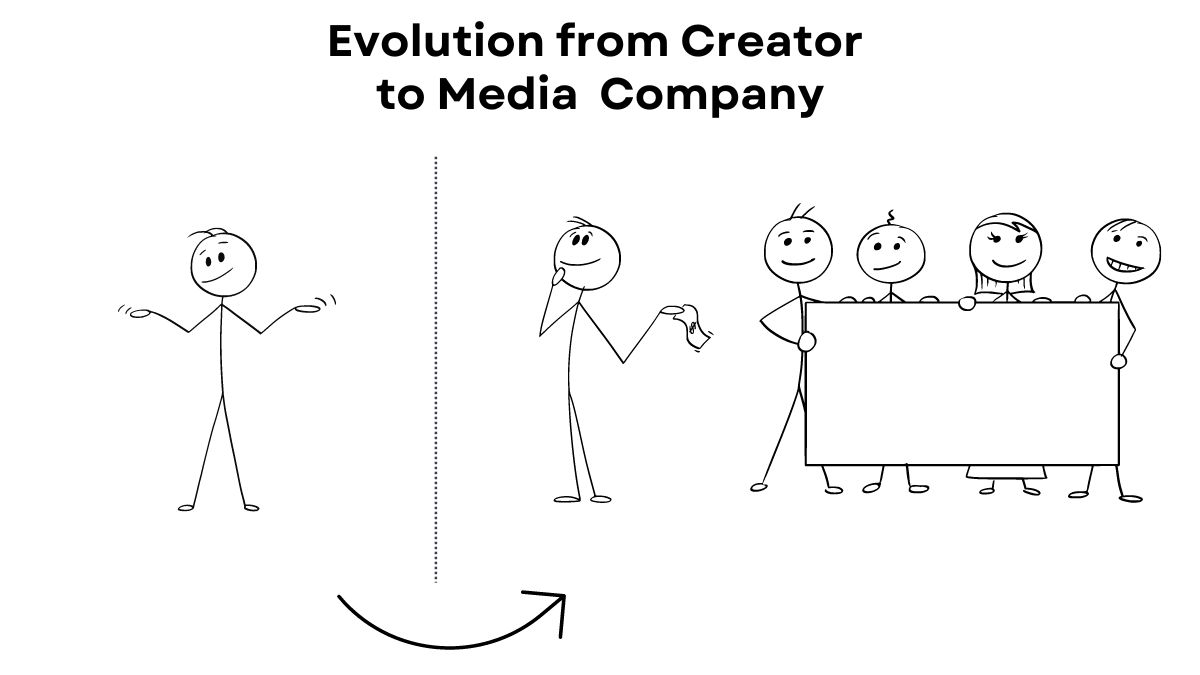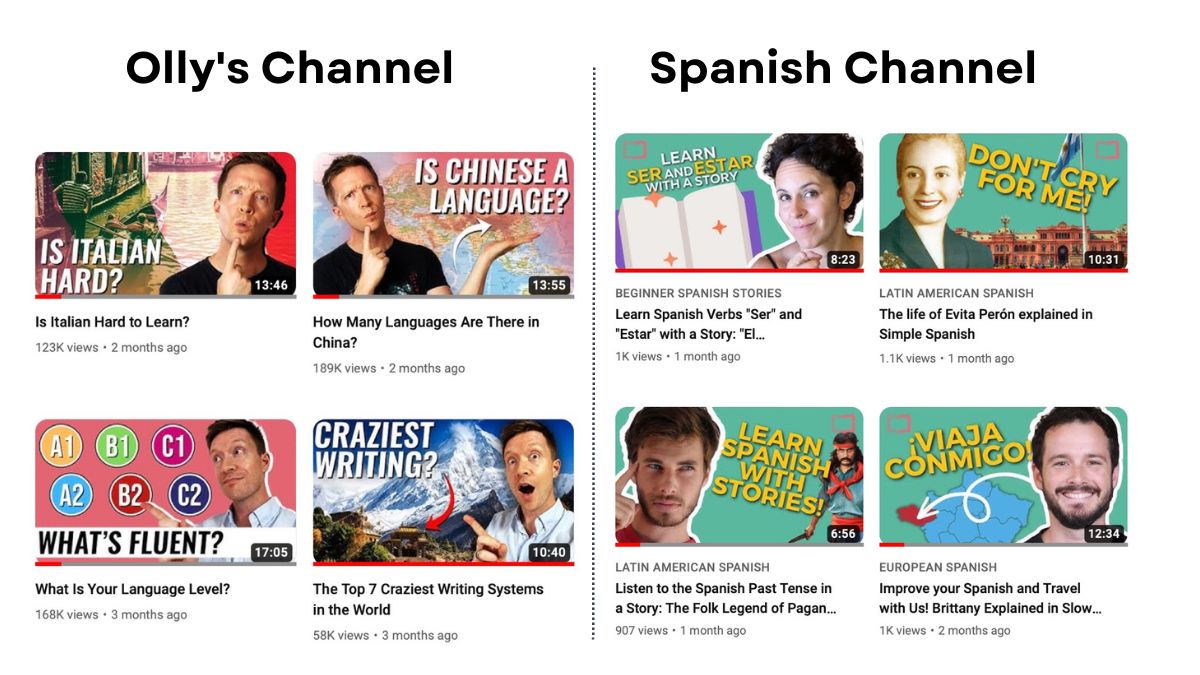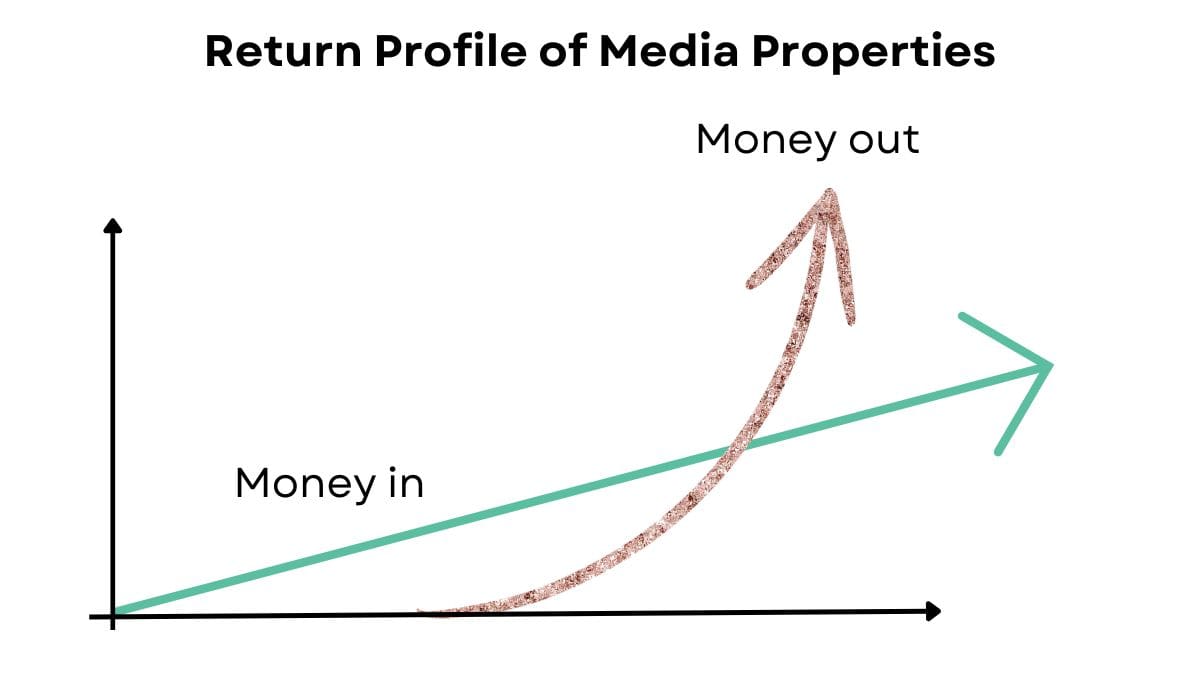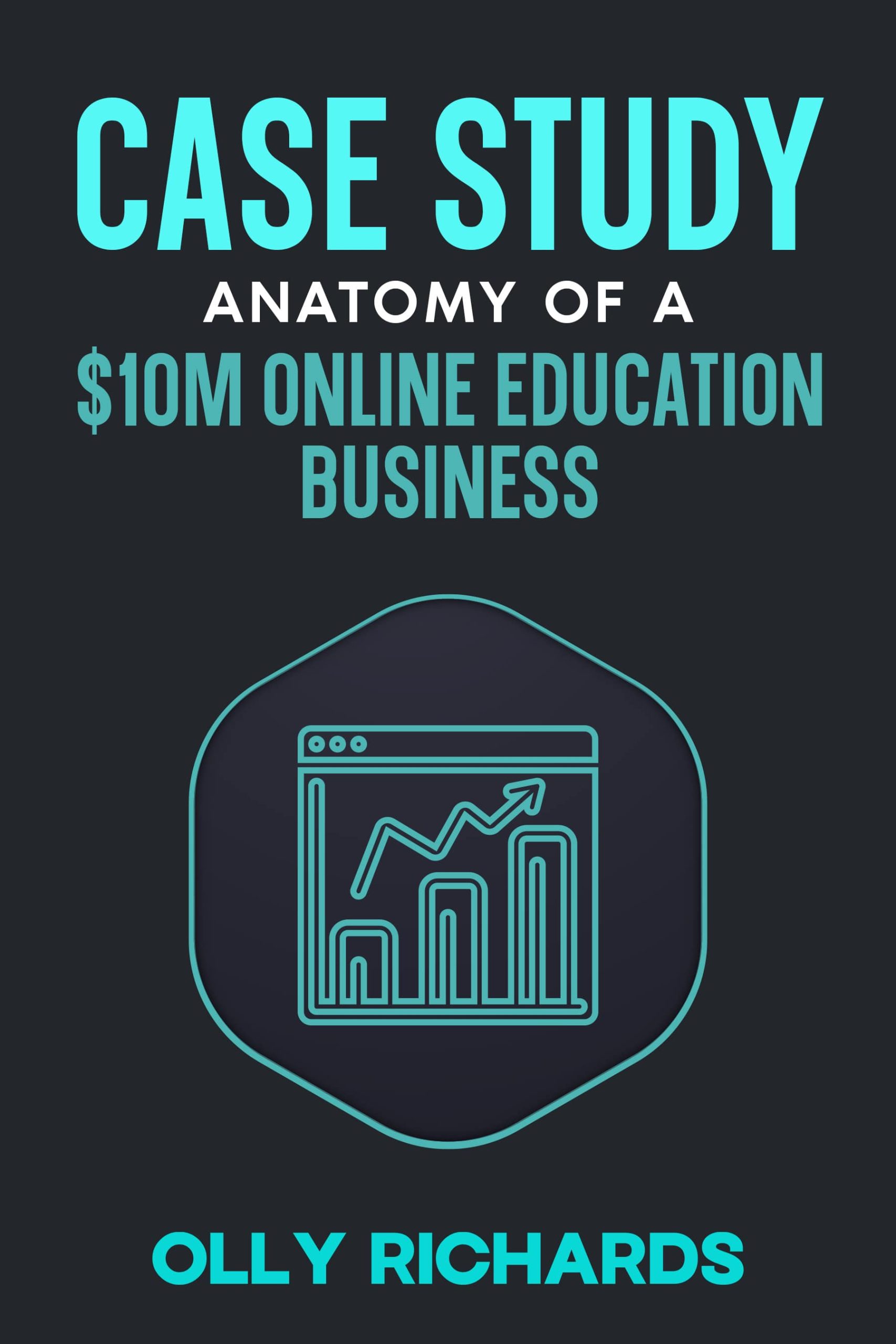We all know that video content is where it’s at.
You’ve seen the insane reach that YouTubers get…
It’s enough to make the humble blogger weep.
(I know… I am one!)
But let’s be real…
You’re not going to start a YouTube channel.

It’s not your thing.
Sure, you could… but you’re just not. You don’t want another full-time job.
But building a new video operation run entirely by other people?
Now we’re talking!
Today, I’m going to break down:
Exactly how you would go about building a video-based media property that doesn’t involve you… so you can explode the reach of your business and step back from the limelight yourself.
(And how I’ve done it, multiple times.)
This is the foundation of how content businesses scale from 6 to 7-figures, and exit for 8.
Buckle up…
A YouTube Channel Run By Other People
As an entrepreneur in online education, you probably started in the same way as the rest of us…
You built your brand around your personal expertise.
Or maybe the expertise of a friend or business partner.
In my case, it was language learning. I spent 15 years learning 10 languages, then started teaching others how to do it.
My foundation was content - written content through blogging, audio content through podcasting, and video content on YouTube.
For those who take content seriously, it’s relatively easy to scale the simple {content + audience + product} formula to a healthy 6-figure revenue.
(I laid out the basics of this in my case study - get it here if you haven’t already.)
For the 1% of outliers who build disproportionately large traffic, low 7-figures is a breeze.
But what I’ve noticed is that solopreneurs tend to cap out at that low 7-figure level.
(These are the people who typically apply to work with us at CreatorEmpires.com)
Here’s why this glass ceiling exists:
Educators rely on their personal brand.
There’s only so much content you can create. Only so much juice you can get from the algorithm. Only so much time that leaves you to continue to grow your business.
Now…
Take a look at larger education businesses.
What do they do differently?
They…
Drive traffic at much larger scale, in a way that’s infinitely scaleable, and doesn’t rely on any one individual.
Take a look at our Creator Empires partner Underknown, with multiple YouTube channels like What If? (7 million subs).
Or the Interesting Engineering channel (closing in on 1m subs).
Or the brilliantly-named Charisma on Command channel (currently 6m subs), which used to be presented by one guy, founder Charlie, who has since managed to work himself out of the channel entirely. (Rare for a creator to achieve.)
If they can do it…
Why can’t you?
In fact, as an online educator, there’s an inevitable and necessary shift over time, from personal brand –> media company.

Today’s newsletter is about how to do it.
Example Of Building A New Media Property
Let me give you an example…
Starting by showing that I practise what I preach.
Over at StoryLearning, we have a successful and fast-growing YouTube channel where I’m the presenter.
(Check the case study if you want to know how I run the channel in only a couple of hours a month.)
It’s actually the only part of the business where I’m actively involved, and I still do it because, frankly, I love it.
However, we’re growing the rest of the our business media with no Olly in sight, including other YouTube channels.
While the main channel is a “general language” channel, another channel we have, StoryLearning Spanish, is focused only on Spanish.

Here are some facts about this new channel:
- I have zero involvement in any part of the channel
- The channel is managed entirely by a team
- There are four individual presenters
At 20k subscribers, it’s still a relatively small channel, but growth is steady.
Here are some facts about this new channel:
- I have zero involvement in any part of the channel
- The channel is managed entirely by a team
- There are four individual presenters
At 20k subscribers, it’s still a relatively small channel, but growth is steady.
The peculiar dynamics of YouTube are that the first 1–2 years are slow and tedious, but growth is exponential after that.
The trick is…
With new media properties, you invest heavily up-front in return for handsome rewards in the future.

So…
You’re probably asking:
- How do I find presenters for the channel?
- How do I convince someone else to make videos for my channel?
- What about managing the channel - editing, thumbnails, production?
- How do I make sure people stick around & don’t bail after 6 months?
And how do you do all this without landing yourself in a new full-time commitment?
I’m glad you asked…
The Mindset Of Building Media
But before we get there, a few notes on mindset…
Because…
Building media properties with other people’s talent is going to feel very different to anything you’ve done before!
I’m talking operationally.
But also financially.
You’ve got to have your head screwed on for this, otherwise you’ll end up…
Getting cold feet after 6 months and bailing on the whole project before you’ve given it a chance to get off the ground!
First up…
This is going to cost money.
Like all growth, building a media channel will suck cash.
Not only that…
Your response will drop.
Whatever metrics you’re used to getting from your own content, expect less across the board.
Lastly…
It’s all going to take time to grow.
For YouTube, I’d budget at least 1–2 years to get traction.
So make sure you can answer “YES” to each of the following questions:
- I can ringfence 24 months of cash to fund the project
- I’m comfortable not seeing any return for 12–24 months
- I can avoid meddling and allow the team to work
From a mindset perspective, this means that you need to be able to stomach a large cash outflow, and underwhelming results for a period of time.
Do you have the disposition for this?
Many people don’t.
(It’s taken me years of conditioning to be able to stomach these longer investment cycles.)
But if you do, there are handsome rewards waiting for you on the other end:
- You have a media brand that’s self-sustaining and can grow independently of you
- You have a media playbook that you can repeat and scale in other areas
- Your business becomes infinitely more attractive to buyers, for the reasons given in this edition of the newsletter
Enough caveats already!
Let’s get to the how-to.
How To Build A Fully-Resourced YouTube Channel
Step 1 - Talent
First things first, I would get 5 people under contract to produce 4 videos a month each.
(That’s 5 videos per week.)
Here’s why:
You don’t know what’s going to work at first, so you want to maximise the surface area of different content experiments.
Over time, you double down on what’s working, possibly reducing the frequency of content to a more sustainable level.
Also, you want to avoid over-reliance on one individual.
Likely, 1–2 people will drop out, so you want to be able to replace them without the whole thing grinding to a halt.
In terms of where to find these people…
I’d start with LinkedIn.
Right now, LinkedIn is red hot for hiring - it’s where everyone goes to look for work. With one single job ad on LinkedIn we got around 600 applications for Spanish talent within a week, and were able to be very selective as a result.
Yes, I know your business is different…
But if we can find people to create story-based Spanish language content on LinkedIn, I’d bet my bottom dollar you can find who you need… whatever type of content you dream up.
Step 2 - Incentives
One question you probably have is:
“Why would anyone stick around and grow my YouTube channel for me?”
Answer:
When incentives are in the right place.
I won’t go into the specifics of what we pay at StoryLearning, but I will say:
- We pay a good price per finish video
- We give 100% of Adsense revenue to presenters
This makes it so that:
- Presenters feel fairly compensated for work week-to-week
- They have a long-term incentive to stick around (as the channel grows and we earn more from Adsense)
Step 3 - Ownership
This is where you buy your freedom and make the whole thing sustainable.
Look:
If you have a lot of free time, you can manage the new channel yourself.
But take it from me…
There’s a lot to think about.
If you get too involved, you’ll end up running around like a long-tailed cat in a room full of rocking chairs.
And that ain’t pretty.
When we started the StoryLearning Spanish channel, the first person we hired was a producer - Sofía.
Sofía’s deliverable is straightforward:
Publish three videos per week.
How she does it, is up to her.
But there’s no doubt over the deliverable.
(As an aside, in my opinion, this is the secret to effective management. Have crystal-clear deliverables and leave the “how-to” to the individuals.)
As project manager, Sofía manages all aspects of production.
And there’s quite a bit:
- Liaising with presenters, agreeing video topics etc
- Adding captions and subtitles to videos
- Thumbnails, video titles, descriptions etc
- Creating PDF downloads
- Ongoing analytics etc
- And, crucially, hitting “publish” three times a week
We agreed all of this up-front, when we first started the project.
And then my job was simply…
To get the hell out of the way!
Step 4 - Brand Frameworks
“But how do I make sure the videos are on-brand and good quality?”
Let me ask you…
How do you make sure anyone on your team does anything?
Set clear expectations.
At the very beginning, we all sat down and asked:
“What are we trying to achieve here?”
“Who is our target audience?”
“What’s the DNA of the content?”
In other words, we all got on the same page about the content that’s needed for the brand.
But after that…
Really the most important thing is to get out of the way.
If you’ve hired creative, competent people, then the best thing you can do is allow people to express themselves and experiment.
People will stun you with their ingenuity and creativity if you just give them the space.
This can be a big challenge for us as “edupreneurs”, though.
Not only are we precious over our content…
But we’re used to doing everything ourselves.
You’ve got to let go, and that’s why my formula for this is:
- Hire for aptitude first
- Train on brand and content
- Set clear deliverables
- Get out of the way
(Again, more on this in Chapter 8 of the case study.)
Growth Through Experimentation
In the last section, I was banging on about hiring the right team and then getting out of the way.
One of the reasons for this is:
Key to the success of a new media project is to build in a culture of experimentation.
You don’t know what’s going to work in advance.
You never do.
And the fastest path to traction is to create a culture where fast experimentation is encouraged.
And where mistakes are encouraged!
(Fun fact, in our team Basecamp, we have a regular prompt for the entire team which is: “What’s something you f***** up at work recently?” The entire reason for this is that we want to normalise mistakes. If people are terrified of repercussions, they won’t take risks.)
So…
While you’re getting the team set up…
And at regular intervals…
Make it clear that you’ve got no problem with mistakes, unexpected results, or whatever…
Provided that:
- They learn from those mistakes
- It comes from a place of experimentation
This really is a question of company culture…
And I’d like to think that if you pinned down any member of the StoryLearning team, and performed enhanced-interrogation under extreme duress, they’d all tell you that they feel completely comfortable experimenting with new things at work.
Invest In The Future Of Your Business
As you’ve seen, building new media properties is not something to be taken lightly.
You definitely don’t want to wake up on a Sunday morning and start a YouTube channel with other people on a whim. Not only that, it will cost you a tonne of money, and take potentially years to grow.
Really, I wonder why anyone would do it.
I suppose it’s because they want traffic like this…

… in a highly-engaging medium, where viewers are hanging off your every word.
This is how powerful, influential companies are built, with protective moats the size of the Mediterranean.
To build new media, you need to have strong, cash reserves, and the resilience to see it through. You need multiple talent, properly incentivised, crystal clear deliverables, a producer to manage production of the channel, clear brand frameworks, and a management culture that encourages experimentation.
Get all of this in place…
Work your socks off…
And over the medium term, you will enjoy the kind of audience growth that dreams are made of, and create the possibility for you to step back from the hamster wheel.
That’s your lot for today.
I wrote this newsletter for one person in particular – if you’re reading this, you know who you are. (I’m rooting for you!)
Questions?
Hit me up on Twitter @mrollyrichards
Namaste,
Olly
CASE STUDY: Blueprint Of A $10m Online Education Business:
Join my free newsletter for online educators and I'll send you the case study immediately...
We will protect your data in accordance with our data policy!

